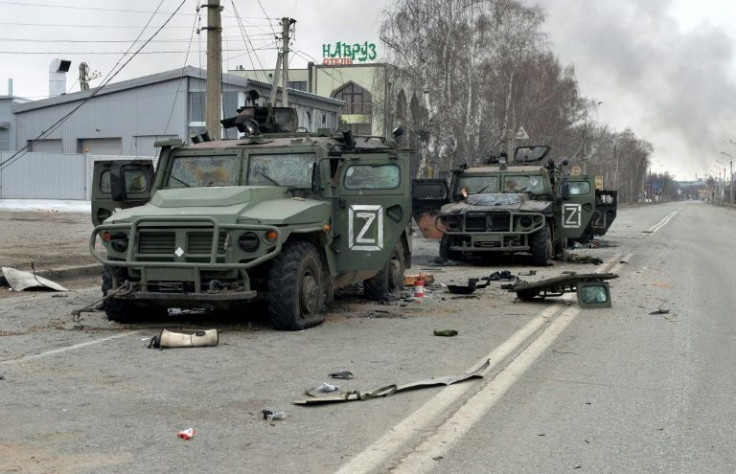With Ukraine Crisis, Arms Manufacturers See Return Of Good Old Days

After the lull, comes the storm. During the COVID-19 pandemic, all economies declined precipitously. However, Russia's invasion of Ukraine last week has thrown open a lucrative arms market before weapons manufacturers worldwide and their share prices have skyrocketed.
The Russian invasion has triggered a sharp turnaround in market sentiment after defense stocks underperformed in the broader market last year.
As the world reverts to a 21st century redux of the Cold War with Russian President Vladimir Putin's decision to attack Ukraine, weapon producers are sitting pretty to improve their bottom line.
Over the past five days, BAe Systems, the largest defense contractor in Europe, saw its share prices astronomically soaring over 21 percent.
Thales, a French arms producer, saw its share prices spectacularly increase over 26 percent. Likewise, U.S. contractors like Lockheed Martin and Raytheon made it merry at Wall Street. Lockheed Martin's shares hit an all-time high March 2. Sweden-based Saab shares rose by a third since the invasion.
The surge in BAe's share price came after its profits increased by 13 percent and revenue increased by 2 percent in 2021.
JP Morgan has upgraded BAe's stock attractiveness, saying increased defense spending by nations would benefit the company.
Charles Woodburn, BAe's chief executive, has said that the NATO nations would have to increase their military spending under pressure from the U.S.
Under the prevailing siege-like situation in Ukraine, the inexorable response of Europe and the U.S. was, arms guaranteeing, which augers well for arms manufacturers to make a massive profit for a foreseeable future, just like in the Cold War era.
In the wake of Russia-Ukraine war, the U.S. and its NATO allies are refurbishing their militaries to improve their individual operational capabilities.
Though the Russian army has been inside the Ukraine territory for a week, it has not achieved any major breakthrough because Ukraine is armed heavily by the western powers.
Its principal assault weapon against the invading Russian army is the advanced FGM-148 fire-and-forget Javelin anti-tank missile (ATM) system, which has the added attraction of thermobaric rockets (T-72 MBTs) which can suck up the surrounding oxygen upon landing and can put to death a large number of people in the vicinity by choking them.
The lethal weapon is a joint venture between Raytheon and Lockheed Martin and was part of the $60 million arms package announced by the U.S. last October in anticipation of a possible Russian military attack.
An additional $350 million military aid announced by U.S. Secretary of State Antony Blinken Feb. 26 is also reported to include a sizeable number of Javelins.
Over the past year, the U.S. has committed more than $1 billion in security aid to Ukraine.
In fact, European defense company valuations improved better than their U.S. counterparts following the Russian invasion. It was mainly driven by Germany's commitment to boost its defense budget and European Union entering the arms market for the first time to help Ukraine. Deviating from its long-standing policy of not exporting weapons to war zones, Germany over the weekend has shown interest in Lockheed-made F-35 combat jets.
Despite the ban on using its normal budget to fund operations with military implications, the 27-member EU trade block, in a historic first, has announced a military aid package to Ukraine. The EU package, some €500 million in arms and other aid to the Ukrainian military, too would comprise Javelins, defense experts noted.
Poland, the immediate neighbor of Russia, wants to buy 250 Abrams battle tanks made by General Dynamics Corp, another leading U.S. military behemoth that is a part of Lockheed Martin, costing $6 billion and was cleared by the State Department Feb. 18.
The UK is mulling to increase its military spending which is currently a little over 2 percent of GDP to as high as 3 percent. The UK has promised military support to Ukraine, including lethal defensive weapons.
The Netherlands will supply air defense rockets and anti-tank systems to Ukraine and has agreed to a Ukrainian proposal to rapidly ship 200 Stinger air defense rockets. Belgium has promised 2,000 machine guns and 3,800 tons of fuel.
Canada is sending lethal military weaponry to Ukraine and has given $394 million in aid to help it defend itself.
Breaking its historic neutral stance, Sweden will send 5,000 anti-tank weapons to Ukraine and Norway is sending up to 2,000 M72 anti-tank weapons.
Military spending could rise as much as 50 percent over the next five years if the U.S. goes for a larger presence in the region and NATO gets its defense budget increased.
Most big arms deals are brokered by the Pentagon and NATO states rather than directly between companies and governments.
According to Transparency International, BAe Systems is the most prolific lobbyist in Europe. From 2020 up to 2021, BAe held 30 meetings with government ministers.
Raytheon, Lockheed Martin, and General Dynamics are the co-founders of the U.S.' Centre for Strategic and International Studies which gives tips to the Joe Biden administration on the global security scenarios.
CEOs of arms producers are on cloud nine and are openly telling their investors that tensions ensure quick bucks for companies.
Greg Hayes, CEO of Raytheon, in his Jan. 25 earnings call, has categorically stated that the current flare-up in Ukraine will help the company reap rich dividends.
On the same day, Jim Taiclet, CEO of Lockheed Martin, told investors that the competition between the U.S. and Russia over Ukraine has ensured more business for the company.
This "great power competition," Taiclet said, will ensure more business for the company.
Hayes, however, suggested that Raytheon's arms are acting as a deterrent to help prevent war.
War profiteering is, of course, not new. However, arms makers get more than they can chew when arms production, as a rule, is dictated by market or profit imperatives.





